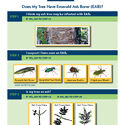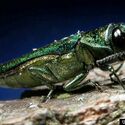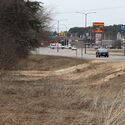Ash borer has hit county
April 29, 2022
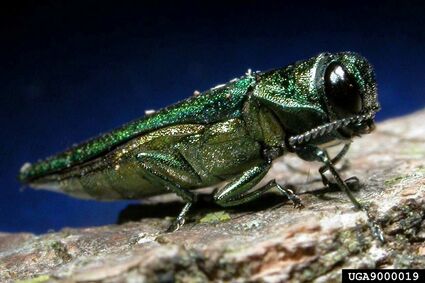
USDA photo
Signs of the emerald ash borer have been confirmed in Cloquet, the first sighting in Carlton County noted by the Minnesota Department of Agriculture.
In pure Minnesotan parlance, it could be worse.
This month, a tree infested with emerald ash borer larvae was spotted in Cloquet, marking the first confirmed sighting of the tree-killing pest in the county. Ash borers have also recently been found in Lake County, especially in Two Harbors, and have been in Duluth for several years.
"The good news is that it's not as rampant in Cloquet," said Kimberly Thielen Cremers, a plant protection expert at the Minnesota Department of Agriculture. In Two Harbors, several ash trees were found in the deep stages of infestation, with bark coming off trunks and tree tops dying.
That one tree was spotted - by a state worker passing through - in a copse of trees off Minnesota Highway 33 in Cloquet, speaks to the expertise of those working on the ash borer problem as well as the likelihood that there are more infected trees in the area.
The emerald ash borer (EAB) has been spreading from the east for decades. Infestations were first discovered in Minnesota in 2009, and there are now 34 counties with confirmed sightings.
EAB was discovered in Superior in 2013 and it had spread to Duluth by 2015.
The tree in Cloquet, spotted in a triangle of trees on the east side of Highway 33, south of Selmser Avenue, had a telltale sign that ash borer experts like Jonathan Osthus can see even while passing by in a vehicle. Woodpeckers love ash borer larva and the tree that caught his attention had plenty of holes in it. He inspected the tree on April 11 and confirmed the infestation.
"He's good at finding EAB," Thielen Cremers said. She laughed, and said he could be hurtling along an interstate and spot an infected tree.
"We do a lot of surveying through windshields," said Angie Ambourn, another MDA plant protection expert. She said Osthus was busy this week checking out the greater infestation around Two Harbors, where EAB was first spotted along the Superior Hiking Trail.
Ambourn said Cloquet has been on the MDA's radar, which is why Osthus was being vigilant while driving through. "Our whole unit is 10 years into this, so we know the signs."
The sighting means that the city of Cloquet will do an inventory of ash trees in parks and on boulevards, said Caleb Peterson, city engineer and director of public works.
City staff have been receiving training on the inevitable presence of EAB, Peterson said.
"It's always been a matter of delaying it," he said. Since the outbreak in Duluth nearly 10 years ago, city workers have been keeping an eye out. Peterson said there are about 1,000 ash trees on public property. There is some grant funding to treat trees with chemicals to stem invasions, which is the recommended response.
The tree spotted off Highway 33 was cut down and grinded because it was so far gone and there are no winged borers that could simply move on to another tree. Warmer months, generally from May 1 to the first frosts of the year, are a bad time to disturb the pests in a tree.
Cloquet has a diverse tree population, Peterson said, meaning that even if all the ash reach critical stages and need to be cut down, there won't be a barren wasteland here.
If a tree canopy reaches a 50-percent loss, the tree will be cut down, Peterson said.
The larvae of the insect are the problem. They tunnel under the bark and feed on the portions of the wood that feed the tree from the roots. The tunneling leaves a telltale "S" pattern under the bark, another way to spot infestation. Split or discolored bark on an ash tree are also signs.
The MDA announced this week that because of the EAB discoveries, there will be quarantines on the movement of firewood in Carlton and Lake counties. The northeast portion of Carlton County will have restrictions on firewood and ash wood use. That quarantine will not go into effect until after a public comment period that runs through June 9.
The EAB finds could have an impact on the wood industry, especially the Sappi mill in Cloquet. It stopped buying ash from Douglas County when EAB was discovered there in 2013. At the time, the mill mixed in a small percentage of ash with aspen and maple to produce specialized cellulose used in clothing and other products. It also buys chips and slash to fuel its biomass boilers. Buying ash from quarantined areas requires a compliance agreement with the federal government.
The MDA has informational meetings posted online and will host a virtual meeting on the latest findings at 10 a.m. May 9. The MDA has links and a host of EAB information on its website, http://www.mda.state.mn.us/eab.
More information
Some items of note on the most recent informational meeting hosted by the Minnesota Department of Agriculture:
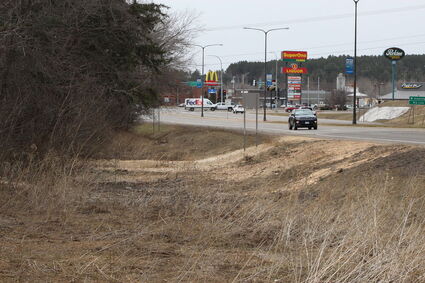
Jana Peterson
Wood chips from an ash tree infested with emerald ash borer larvae are visible along Minnesota Highway 33 in Cloquet this week. A state worker noticed a tree riddled with holes from woodpeckers, which feast on the larvae. Workers cut down and grinded the tree on Monday.
• Woodpecker activity is a top sign of tree infestation, as well as the "S" shaped feeding marks left under the bark of a tree.
• Damage to a tree will be found mid-trunk and higher.
• It can take about five years for a tree to die after being infested. EAB is spreading about one or two miles a year.
• Injections of insect repellant are recommended for larger trees. Ground-soaking with chemicals can work with smaller trees. Professionals are required for tree injections, while soaking materials can be purchased by property owners. Injection treatments cost $7 to $10 per diameter-inch of the tree. Treatments last for about two years. Often treatment is recommended as a lower-cost option to cutting a tree down.
• Property owners who suspect a tree has been infested with EAB should call the MDA office at 888-545-6684. There is also a reporting portal on the MDA website: http://www.mda.state.mn.us/eab.


